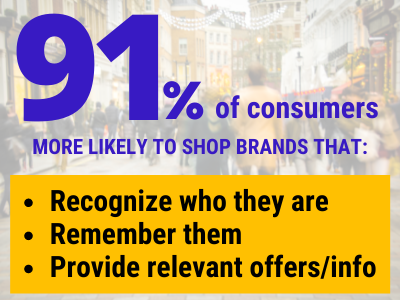The ability to connect with consumers on a 1 to 1 basis is the holy grail of marketing. In the world of advertising, the idea that a brand will one day have a direct line of communication with their consumers and be able to customize ad messaging to each one 100% of the time is considered marketing nirvana. Why? Because personalized, 1 to 1 marketing means as a brand you’re delivering the right product, with the right message, to the right person at the right time. This level of marketing sophistication can ensure a high level of brand loyalty, a larger market share, and a maximum return on every marketing dollar spent. And truth be told, according to a study done by Accenture, consumers actually yearn for better advertising experiences and reward those brands that recognize, remember, and provide them with relevant offers and information.
But will personalized, 1 to 1 advertising ever really be possible, and if so, when, and how? Although I make no promises on timing, I will stick my neck out and propose it is more possible, even more probable, than we think. Currently, there are certain digital forces at work that, if combined, could produce the right circumstances for true 1 to 1 marketing to take root. Below is one scenario that makes use of either current technology, or that which is quickly becoming available and advancing in capabilities. While each advancement is powerful in its own right, when they work together, you may just indeed have marketing nirvana.
SMART IMMERSIVE CONTENT
The starting point for this would be scenario is smarter content and smarter ads; because if content doesn’t evolve then 1 to 1 marketing will be nearly impossible. When the average person spends nearly 8 hours daily on device (aka smartphone), the staid, two-dimensional still and video formats we’ve been using since the early days of the internet are the first things that must change. While these formats have served their purpose in that they have supported the growth of a flourishing internet economy, they have also contributed to an environment where consumers now block the ads that are paying for the very content they’re consuming. These “flat” ads, even when in the form of a video, are passive experiences yielding only a limited “one-way” conversation. In these kinds of ads, the brand does all the talking (in some cases yelling) and the consumer is forced to view an ad. In most cases the consumer simply tunes out and ignores the ad entirely or just keeps their eyes on the proverbial “skip ad” button. So, for personalized 1 to 1 marketing to exist branded content must become a two-way conversation, and ideally, one in which the consumer is in control. Most of the digital ad formats that are currently in use today, like banner ads, native ads and video ads, simply don’t support this kind of 1:1 relationship. That’s because these kinds of ads are largely non-interactive, unresponsive, and provide close to zero information if the consumer doesn’t click.

There is hope, however. As we wade into the waters of the metaverse, it’s immersive media (360, 3D, AR, VR, Holographic) that glimmers as a beacon of hope for brands and agencies as they look to offer consumers more personalized, multi-dimensional, and interactive brand experiences to naturally invite the consumer to engage. Because immersive media generally relies on mobile sensors to enhance exploration, navigation, or the viewing of branded content companies can also tell bigger brand stories, show more product and messaging in a single viewing, allowing consumers to virtually test, even customize products.
From a data perspective, immersive media can provide brands and advertisers with a wealth of information pertaining to how consumers engage with their branded content. The ability to track eye movement, control screen position and orientation, geo-positioning, and dwell-time allows marketers to track consumer behavior without needing them to click on anything creating what we call “behavioral data”. It’s this behavioral data that is essential to creating personalized experiences and immersive media can capture this data inside of its own content, giving marketers a way of connecting directly with the consumer and isolating the experiences to a single person – something not currently available with today’s ad formats. The ability for content to store and transmit information from inside is essential in order for the IoT and blockchain to help complete the circle. Once you can efficiently and effectively capture and transmit data from within content, or what we will now call “smart content”, then you can go to step two.

NEW BRAND DATA & AI
When you want to reduce cost in a distribution chain you cut out the middleman, when you want to get closer to the consumer in digital advertising you either cut out the programmatic networks. Currently, the massive, inefficient and convoluted programmatic ecosystem is where all of the consumer data is being tracked and, in many cases, lost. But, for brands to connect directly with consumers, they must be able to connect “directly” with consumers without depending as heavily on 3rd party network providers. The smart nature of immersive content gives brands this ability.
A direct link to the consumer gives marketers two important advantages: 1) the ability to respond faster and in a more seamless way, and 2) the ability to directly change content, messaging, or product offering on the fly based on real-time behavioral, purchasing, location, and other data tracking. Now brands have the data necessary to enact “real-time” optimization of content, messaging, or product offering because they have direct and instantaneous access to the consumer data. Data inside of content accelerates the response time because there is no network friction to slow it down and algorithms and AI can be applied. On the other side, when smart ads are combined with immersive media formats consumers have a direct, secured link to the brand to tell them where, when, and how they want the brand to engage. When successfully done, the brand experience of the future will feel like a natural extension of the consumer’s daily life, allowing them to behave and act in normal everyday ways while the brand circles around them in an ever-present-way blurring the line between “is the brand marketing to the consumer?” or “the consumer marketing to the brand?”
THE I.O.T.
The next step on our way to 1 to 1 marketing nirvana is the IoT. The Internet of Everything means we will be universally connected to digital technology nearly everywhere we go. From our kitchen to our car, office, retail, restaurants, and the gym, our vital signs, personal needs, wants, preferences, will be enhanced and managed by our favorite brands. For example, we only need to tap our smartwatch, earphones, glasses, or wearable technology to curate, select, buy, or integrate almost anything organically into our lives as we move through our day. When a digital ecosystem can track our interactivity across all devices (large or small), consumers will generate an enormous amount of behavior, geographical, and ecommerce data that marketers can respond to in real-time. When consumers are in control and brands can “cater” to our every need, companies become more profitable. The use of the IoT reverses the way in which marketer’s target consumers because it assigns more value and ROI to a consumer looking for a brand than a brand for a consumer.

BLOCKCHAIN…THE ULTIMATE PRIVACY ANSWER
The last step to our 1 to brand brand-consumer relationship journey is Blockchain. To obtain true personalization you need large amounts of data that can be effectively managed and privately handled. Blockchain is the only solution that allows for big-data scalability while at the same time ensuring consumer privacy. The proverbial straw that breaks the marketing 1:1 camel’s back is privacy. Blockchain gives us the ability to scale enormous amounts of data that is easily accessible, but consumers will never provide enough personal information to make 1:1 marketing possible if there is any risk of it becoming public. Blockchain provides the ultimate form of consumer protection because it allows the consumer to control their information and privacy. With Blockchain, consumers own their own data and they determine who, when, how, and how much information brands have access to. Brands that prove they can honor this trust will get more information and be more successful. Those that don’t, won’t. And this is why 1 to 1 marketing can work.
Ok, but is this scenario realistic? If the combination of these technologies can create circumstances in which ad networks and exchanges are perhaps not eliminated but at least allow brands to directly connect with consumers, inside an ecosystem that ensures they can safely engage at high levels of interactivity that is able to drive the necessary levels of personalization, then yes. But will the consumer buy into it? What is in it for them? In short, consumers give up personal information to enjoy a better lifestyle. They can finally say goodbye to force fed, interruptive, and annoying advertising and marketing and hello to brand content that is always relevant, timely, and helpful. Even better, it’s your data, you own and control your information. You decide to connect only with those brands you truly enjoy and feel bring value to your life. Your privacy is protected (blockchain) so you feel safe giving up personal information to get brand experiences that help you live a happier, more productive and rewarding life. Brands, in exchange, get loyalty, a near-100% return on their marketing dollars, and a bigger piece of each consumer’s spending pie. Sounds like a match made in “brand-heaven”!

Written by Robert Bruza with contributions from Laura Barton
